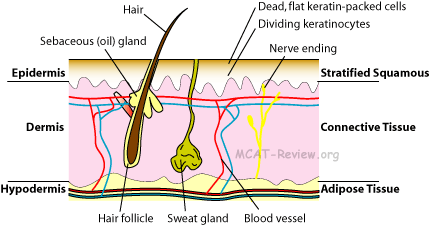|
|
Functions in homeostasis and osmoregulation
- Heat homeostasis:
- Too cold: hair stands up (goose bumps), vasoconstriction decreases blood supply at skin (less heat loss).
- Too hot: sweat (evaporative cooling), vasodilation increases blood supply at skin (more heat loss).
- Water homeostasis: Insulates body against water loss.
- Osmoregulation: sweat excretes salts and nitrogenous wastes (urea, uric acid, ammonia)
- Some other functions of the skin:
- protect against UV radiation by making melanin (absorbs UV)
- make vitamin D upon exposure to sunlight.
- Act as blood reservoir. Vasoconstriction in skin shunts blood to other organs.
- Sense touch, pressure, pain, heat, cold.
- Protection.
Functions in thermoregulation
- hair, erectile musculature
- hairs help insulate the body by trapping air in them.
- Normally hair lies at an angle to the skin, with erectile muscle attaching to it.
- When it's cold, erectile muscles contract, and the hair stands up. This erect position helps hair to trap more air, providing better insulation.
- fat layer for insulation: fat in hypodermis act as insulation.
- sweat glands, location in dermis: produce sweat, cools the body by evaporative cooling.
- vasoconstriction and vasodilation in surface capillaries
- When it's cold: vasoconstriction of arterioles reduce blood supply to skin capillaries. Leads to less heat loss at skin surface.
- When it's hot: vasodilation of arterioles increase blood supply to the skin capillaries. Leads to more heat loss at skin surface.
Physical protection
- nails, calluses, hair
- nail = hard keratin = tougher than the soft keratin on skin.
- calluses = extra thick layer of dead keratin-packed cells on the surface of skin.
- hair = hard keratin.
- protection against abrasion, disease organisms
- Keratin protect skin against abrasion.
- The tight seal made from keratin-packed cells and glycolipids form a barrier against pathogens.
- Chemical protection: Sweat is acidic, contains antibodies, and antimicrobial agents. Sebum (skin oil) kills bacteria.
- Natural flora: good bacteria on the surface of skin don't cause harm to you, and they fight off bad bacteria that can harm you.
Structure

- layer differentiation, cell types, tissue types (epithelial, connective)
- Epidermis = stratified squamous epithelial tissue = protection
- Keratinocytes = cells that produce keratin = dominates the epidermis.
- Keratinocytes start off like normal cells at the bottom of the epidermis, but gets flatter as you go up, and becomes dead, keratin plates at the surface of the skin.
- Melanocytes = cells that make melanin, the skin pigment.
- Dendritic cells (Langerhans cells) = phagocytes that eat pathogen and present foreign antigens to activate immune response.
- Dermis = connective tissue = blood, nerve supply
- Fibroblasts = make fiber and ground substance (glue) for the extracellular matrix that makes up connective tissue.
- Hair follicles, sweat glands, and oil (sebum) glands.
- Blood vessels and nerves.
- Hypodermis = adipose tissue = absorbs shock and provides insulation.
- Review tissue types here
- relative impermeability to water: due to layer of dead, keratin-packed cells sealed with glycolipids.
- Keratin is water insoluble, and layers of dead, keratin-packed cells reside on the skin surface.
- Glycolipids seal the space between the dead keratin-packed cells.
- Sebum (skin oil) contribute some. But oil glands are not present everywhere (absent in palms and soles).
|
|

